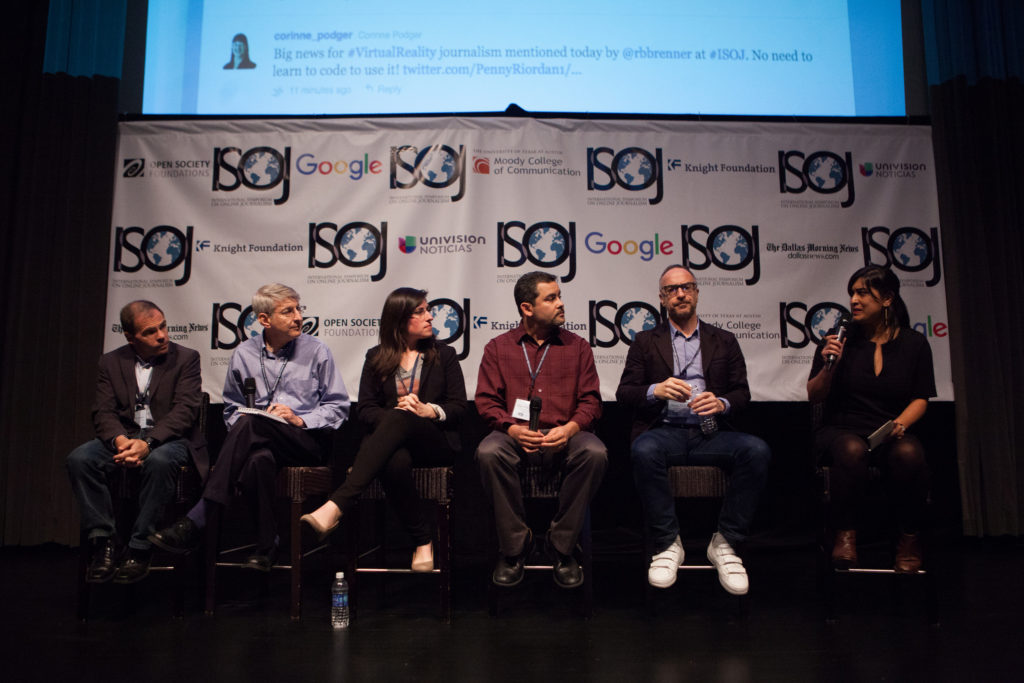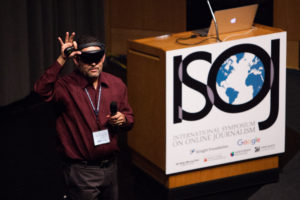April 16, 2016 | Featured, Virtual Reality
Virtual reality has potential to enhance storytelling but logistics are uncertain, journalism experts state at ISOJ
Journalism experts expressed optimism for the future of virtual reality in the field during a panel at the International Symposium on Online Journalism (ISOJ) on Saturday, April 16, stating that much is still uncertain and current issues include the skills required to produce content, its availability to the public, cost and developing ethical standards around the storytelling tool.
The panel was chaired by Shazna Nessa, a Knight Foundation journalism program director.
Panelists said virtual reality, often referred to as VR, has increasingly been put into use over the past several years by major national news organizations and is shifting out of its experimental phase. Most current VR content must be viewed with technology not usually available to the general public, such as complex headsets.

“It really is something fundamentally different to be able to do that, to be able to go inside a story and feel like you were there, to be able to interact with different parts of it,” said Dan Pacheco, professor of journalism innovation at Syracuse University.
He said there are four main types of VR content being implemented: 360-degree video, VR through the use of a phone with a paired headset, “sit down and walk around,” and mixed reality is on the horizon.
Jamie Pallot, co-founder of VR company Emblematic Group, said ideal uses for VR in media are simulating off-limit locations, narratives in which understanding the dimensions of an event are important, scenarios where interaction increases the impact of a story and the recreation of past events.
He cited Emblematic Group’s creation of “One Dark Night,” a VR app that allows users through the use of a headset to experience the scene of the 2012 shooting death of unarmed black teen Trayvon Martin by neighborhood watch member George Zimmerman.
Tom Kent, standards editor for the Associated Press, mentioned a piece The Guardian did titled “6×9: An Immersive Experience of Solitary Confinement,” looking at the conditions of a solitary confinement cell through the use of a headset.
Carla Borrás, series coordinating producer for the PBS series FRONTLINE, said while the novelty of VR has helped it to gain traction to this point, its ability to enhance content will be vital to future success.
“I think story is going to become king,” Borrás said.

R. B. Brenner, director of the University of Texas School of Journalism, said UT is working to create software that allows journalists to make VR content without having to use code, as complex coding knowledge is usually only present in the newsrooms of major media organizations.
Kent, focusing on the ethics of VR, said content producers often use guesswork to make a full virtual narrative and the lack of complete accuracy is something that should at least be disclosed, though how a disclosure should be made is still undetermined.
“Producers do start with reality, but there’s a great temptation to take some artistic license,” Kent said. “Some people say it requires some artistic license.”
He said that because 360-degree cameras used in VR capture all angles of a situation, it increases the discussion on when content should not be shown, giving the faces of Syrian children washed up dead on a Turkey shoreline as a real-world example.
“What we do from now on in the next couple years will determine what kind of credibility it’s going to have,” Kent said.
The 17th ISOJ was held April 15-16 at the Blanton Museum of Art on the campus of the University of Texas at Austin. Video from both days can be found here in English, and here in Spanish.
The 18th annual ISOJ is scheduled for April 21-22, 2017, in Austin, Texas.
ISOJ 2016: Virtual Reality Panel, from Knight Center on Vimeo.

